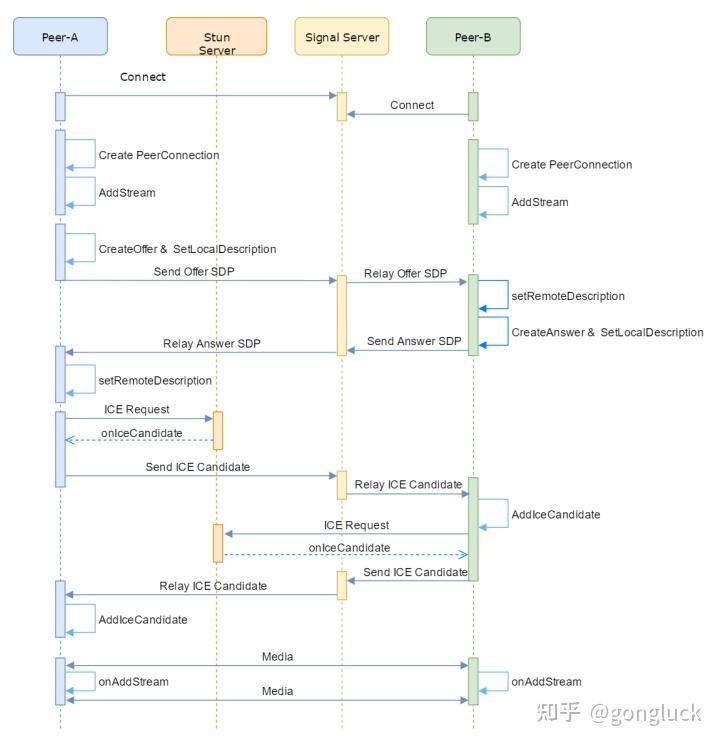设置Android WebRTC连接时的端口


一般情况下,WebRTC连接时选择的网络端口是随机的。基于业务需求,需要在Android端设置指定的端口。
一开始毫无头绪,WebRTC Android的SDK没有找到对应的接口,网上也没找到相关资料。
索性追寻源码,看可以在哪里设置这个端口值。
createPeerConnection
createPeerConnection创建管理p2p连接的实例对象。有很多个重载版本,但是最终都是调用createPeerConnectionInternal。
/**
* Deprecated. PeerConnection constraints are deprecated. Supply values in rtcConfig struct
* instead and use the method without constraints in the signature.
@Nullable
@Deprecated
public PeerConnection createPeerConnection(PeerConnection.RTCConfiguration rtcConfig,
MediaConstraints constraints, PeerConnection.Observer observer) {
return createPeerConnectionInternal(
rtcConfig, constraints, observer, /* sslCertificateVerifier= */ null);
* Deprecated. PeerConnection constraints are deprecated. Supply values in rtcConfig struct
* instead and use the method without constraints in the signature.
@Nullable
@Deprecated
public PeerConnection createPeerConnection(List<PeerConnection.IceServer> iceServers,
MediaConstraints constraints, PeerConnection.Observer observer) {
PeerConnection.RTCConfiguration rtcConfig = new PeerConnection.RTCConfiguration(iceServers);
return createPeerConnection(rtcConfig, constraints, observer);
@Nullable
public PeerConnection createPeerConnection(
List<PeerConnection.IceServer> iceServers, PeerConnection.Observer observer) {
PeerConnection.RTCConfiguration rtcConfig = new PeerConnection.RTCConfiguration(iceServers);
return createPeerConnection(rtcConfig, observer);
@Nullable
public PeerConnection createPeerConnection(
PeerConnection.RTCConfiguration rtcConfig, PeerConnection.Observer observer) {
return createPeerConnection(rtcConfig, null /* constraints */, observer);
@Nullable
public PeerConnection createPeerConnection(
PeerConnection.RTCConfiguration rtcConfig, PeerConnectionDependencies dependencies) {
return createPeerConnectionInternal(rtcConfig, null /* constraints */,
dependencies.getObserver(), dependencies.getSSLCertificateVerifier());
}createPeerConnectionInternal
createPeerConnectionInternal继续往下调用nativeCreatePeerConnection,即JNI_PeerConnectionFactory_CreatePeerConnection方法。
/**
* Internal helper function to pass the parameters down into the native JNI bridge.
@Nullable
PeerConnection createPeerConnectionInternal(PeerConnection.RTCConfiguration rtcConfig,
MediaConstraints constraints, PeerConnection.Observer observer,
SSLCertificateVerifier sslCertificateVerifier) {
checkPeerConnectionFactoryExists();
long nativeObserver = PeerConnection.createNativePeerConnectionObserver(observer);
if (nativeObserver == 0) {
return null;
long nativePeerConnection = nativeCreatePeerConnection(
nativeFactory, rtcConfig, constraints, nativeObserver, sslCertificateVerifier);
if (nativePeerConnection == 0) {
return null;
return new PeerConnection(nativePeerConnection);
}JNI_PeerConnectionFactory_CreatePeerConnection
JNI_PeerConnectionFactory_CreatePeerConnection主要解析约束关系和其他设置参数,然后调用CreatePeerConnectionOrError真正的创建PeerConnection。
static jlong JNI_PeerConnectionFactory_CreatePeerConnection(
JNIEnv* jni,
jlong factory,
const JavaParamRef<jobject>& j_rtc_config,
const JavaParamRef<jobject>& j_constraints,
jlong observer_p,
const JavaParamRef<jobject>& j_sslCertificateVerifier) {
std::unique_ptr<PeerConnectionObserver> observer(
reinterpret_cast<PeerConnectionObserver*>(observer_p));
PeerConnectionInterface::RTCConfiguration rtc_config(
PeerConnectionInterface::RTCConfigurationType::kAggressive);
JavaToNativeRTCConfiguration(jni,
j_rtc_config, &rtc_config);
if (rtc_config.certificates.empty()) {
// Generate non-default certificate.
rtc::KeyType key_type = GetRtcConfigKeyType(jni, j_rtc_config);
if (key_type != rtc::KT_DEFAULT) {
rtc::scoped_refptr<rtc::RTCCertificate> certificate =
rtc::RTCCertificateGenerator::GenerateCertificate(
rtc::KeyParams(key_type), absl::nullopt);
if (!certificate) {
RTC_LOG(LS_ERROR) << "Failed to generate certificate. KeyType: "
<< key_type;
return 0;
rtc_config.certificates.push_back(certificate);
std::unique_ptr<MediaConstraints> constraints;
if (!j_constraints.is_null()) {
constraints = JavaToNativeMediaConstraints(jni, j_constraints);
CopyConstraintsIntoRtcConfiguration(constraints.get(), &rtc_config);
PeerConnectionDependencies peer_connection_dependencies(observer.get());
if (!j_sslCertificateVerifier.is_null()) {
peer_connection_dependencies.tls_cert_verifier =
std::make_unique<SSLCertificateVerifierWrapper>(
jni, j_sslCertificateVerifier);
auto result =
PeerConnectionFactoryFromJava(factory)->CreatePeerConnectionOrError(
rtc_config, std::move(peer_connection_dependencies));
if (!result.ok())
return 0;
return jlongFromPointer(new OwnedPeerConnection(
result.MoveValue(), std::move(observer), std::move(constraints)));
CreatePeerConnectionOrError
CreatePeerConnectionOrError设置传入的设置参数,创建PeerConnection。
RTCErrorOr<rtc::scoped_refptr<PeerConnectionInterface>>
PeerConnectionFactory::CreatePeerConnectionOrError(
const PeerConnectionInterface::RTCConfiguration& configuration,
PeerConnectionDependencies dependencies) {
RTC_DCHECK_RUN_ON(signaling_thread());
RTC_DCHECK(!(dependencies.allocator && dependencies.packet_socket_factory))
<< "You can't set both allocator and packet_socket_factory; "
"the former is going away (see bugs.webrtc.org/7447";
// Set internal defaults if optional dependencies are not set.
if (!dependencies.cert_generator) {
dependencies.cert_generator =
std::make_unique<rtc::RTCCertificateGenerator>(signaling_thread(),
network_thread());
if (!dependencies.allocator) {
rtc::PacketSocketFactory* packet_socket_factory;
if (dependencies.packet_socket_factory)
packet_socket_factory = dependencies.packet_socket_factory.get();
packet_socket_factory = context_->default_socket_factory();
dependencies.allocator = std::make_unique<cricket::BasicPortAllocator>(
context_->default_network_manager(), packet_socket_factory,
configuration.turn_customizer);
dependencies.allocator->SetPortRange(
configuration.port_allocator_config.min_port,
configuration.port_allocator_config.max_port);
dependencies.allocator->set_flags(
configuration.port_allocator_config.flags);
if (!dependencies.async_resolver_factory) {
dependencies.async_resolver_factory =
std::make_unique<webrtc::BasicAsyncResolverFactory>();
if (!dependencies.ice_transport_factory) {
dependencies.ice_transport_factory =
std::make_unique<DefaultIceTransportFactory>();
dependencies.allocator->SetNetworkIgnoreMask(options().network_ignore_mask);
dependencies.allocator->SetVpnList(configuration.vpn_list);
std::unique_ptr<RtcEventLog> event_log =
worker_thread()->Invoke<std::unique_ptr<RtcEventLog>>(
RTC_FROM_HERE, [this] { return CreateRtcEventLog_w(); });
std::unique_ptr<Call> call = worker_thread()->Invoke<std::unique_ptr<Call>>(
RTC_FROM_HERE,
[this, &event_log] { return CreateCall_w(event_log.get()); });
auto result = PeerConnection::Create(context_, options_, std::move(event_log),
std::move(call), configuration,
std::move(dependencies));
if (!result.ok()) {
return result.MoveError();
// We configure the proxy with a pointer to the network thread for methods
// that need to be invoked there rather than on the signaling thread.
// Internally, the proxy object has a member variable named `worker_thread_`
// which will point to the network thread (and not the factory's
// worker_thread()). All such methods have thread checks though, so the code
// should still be clear (outside of macro expansion).
rtc::scoped_refptr<PeerConnectionInterface> result_proxy =
PeerConnectionProxy::Create(signaling_thread(), network_thread(),
result.MoveValue());
return result_proxy;
怎样设置自定义端口号?
CreatePeerConnectionOrError里面
if (!dependencies.allocator) {
rtc::PacketSocketFactory* packet_socket_factory;
if (dependencies.packet_socket_factory)
packet_socket_factory = dependencies.packet_socket_factory.get();
packet_socket_factory = context_->default_socket_factory();
dependencies.allocator = std::make_unique<cricket::BasicPortAllocator>(
context_->default_network_manager(), packet_socket_factory,
configuration.turn_customizer);
dependencies.allocator->SetPortRange(
configuration.port_allocator_config.min_port,
configuration.port_allocator_config.max_port);
dependencies.allocator->set_flags(
configuration.port_allocator_config.flags);
就是设置端口范围。而且这里的条件是dependencies.allocator为空才会将configuration.port_allocator_config的端口范围设置进来。dependencies和configuration都是传入参数,所以反推到上一层调用。
JNI_PeerConnectionFactory_CreatePeerConnection里面创建dependencies和configuration。
std::unique_ptr<PeerConnectionObserver> observer(
reinterpret_cast<PeerConnectionObserver*>(observer_p));
PeerConnectionInterface::RTCConfiguration rtc_config(
PeerConnectionInterface::RTCConfigurationType::kAggressive);
JavaToNativeRTCConfiguration(jni, j_rtc_config, &rtc_config);
if (rtc_config.certificates.empty()) {
// Generate non-default certificate.
rtc::KeyType key_type = GetRtcConfigKeyType(jni, j_rtc_config);
if (key_type != rtc::KT_DEFAULT) {
rtc::scoped_refptr<rtc::RTCCertificate> certificate =
rtc::RTCCertificateGenerator::GenerateCertificate(
rtc::KeyParams(key_type), absl::nullopt);
if (!certificate) {
RTC_LOG(LS_ERROR) << "Failed to generate certificate. KeyType: "
<< key_type;
return 0;
rtc_config.certificates.push_back(certificate);
std::unique_ptr<MediaConstraints> constraints;
if (!j_constraints.is_null()) {
constraints = JavaToNativeMediaConstraints(jni, j_constraints);
CopyConstraintsIntoRtcConfiguration(constraints.get(), &rtc_config);
PeerConnectionDependencies peer_connection_dependencies(observer.get());
if (!j_sslCertificateVerifier.is_null()) {
peer_connection_dependencies.tls_cert_verifier =
std::make_unique<SSLCertificateVerifierWrapper>(
jni, j_sslCertificateVerifier);
}CopyConstraintsIntoRtcConfiguration复制约束到Configuration。
void CopyConstraintsIntoRtcConfiguration(
const MediaConstraints* constraints,
PeerConnectionInterface::RTCConfiguration* configuration) {
// Copy info from constraints into configuration, if present.
if (!constraints) {
return;
bool enable_ipv6;
if (FindConstraint(constraints, MediaConstraints::kEnableIPv6, &enable_ipv6,
nullptr)) {
configuration->disable_ipv6 = !enable_ipv6;
FindConstraint(constraints, MediaConstraints::kEnableDscp,
&configuration->media_config.enable_dscp, nullptr);
FindConstraint(constraints, MediaConstraints::kCpuOveruseDetection,
&configuration->media_config.video.enable_cpu_adaptation,
nullptr);
// Find Suspend Below Min Bitrate constraint.
FindConstraint(
constraints, MediaConstraints::kEnableVideoSuspendBelowMinBitrate,
&configuration->media_config.video.suspend_below_min_bitrate, nullptr);
ConstraintToOptional<int>(constraints,
MediaConstraints::kScreencastMinBitrate,
&configuration->screencast_min_bitrate);
ConstraintToOptional<bool>(constraints,
MediaConstraints::kCombinedAudioVideoBwe,
&configuration->combined_audio_video_bwe);
// gongluck begin add port constraints
//添加端口约束
FindConstraint(constraints, kMinPort,
&configuration->port_allocator_config.min_port, nullptr);
FindConstraint(constraints, kMaxPort,
&configuration->port_allocator_config.max_port, nullptr);
configuration->set_port_allocator_flags(cricket::kDefaultPortAllocatorFlags);
// gongluck end add port constraints
}我修改了源码,在最后处理我自定义的约束名称,设置端口范围。
查看PeerConnectionDependencies的构造函数
PeerConnectionDependencies::PeerConnectionDependencies(
PeerConnectionObserver* observer_in)
: observer(observer_in) {}
PeerConnectionDependencies::PeerConnectionDependencies(
PeerConnectionDependencies&&) = default;没有对
std::unique_ptr<cricket::PortAllocator> allocator;做任何处理,我们也不用做任何修改。
最后,重新编译源码。使用时设置端口约束
MediaConstraints constraints = new MediaConstraints();
constraints.mandatory.add(
new MediaConstraints.KeyValuePair("gMinPort", "20202")
constraints.mandatory.add(
new MediaConstraints.KeyValuePair("gMaxPort", "20202")
